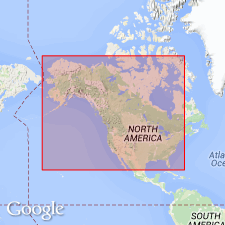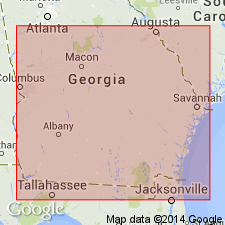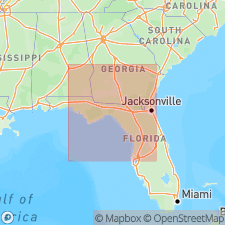
- Usage in publication:
-
- Sopchoppy limestone
- Modifications:
-
- Named
- Dominant lithology:
-
- Limestone
- AAPG geologic province:
-
- South GA-North FL sedimentary province
Summary:
Sopchoppy limestone is a very soft limestone containing numerous imprints of shells and many fragments of vertebrate ribs and other bones, also Conrad's orbitolite and about 30 species of shells, most which are common to Chipola marl or ORTHAULAX bd. The horizon is probably not far from that of Chipola marl. Thickness is unknown. Considered to be of early Miocene age. Named for exposures at Sopchoppy, Wakulla Co., FL.
Source: GNU records (USGS DDS-6; Reston GNULEX).

- Usage in publication:
-
- Sopchoppy Member
- Modifications:
-
- Reinstated
- AAPG geologic province:
-
- South GA-North FL sedimentary province
Summary:
Sopchoppy Member, lower member of the Torreya Formation of the Hawthorne Group, is recognized in this paper as a formal lithostratigraphic unit. Although the original informal unit was called a limestone by Dall (1892), author has observed several lithofacies along the Sopchoppy River. Two dominant ones include a sandy, fossiliferous limestone, and a tough, phosphatic, dolomitic sand. Member appears to be restricted to the Apalachicola Embayment and its flanks, and appears to occur as far north as Gadsden Co., FL, and southern Decatur and Grady Cos., GA. There are no known exposures aside from those along Sopchoppy River and in tributary streams nearby. Neither upper nor lower boundaries are exposed. Unit appears to gradationally overlie the lower fossiliferous, sandy limestones of the Torreya and to conformably underlie the Dogtown Clay Member (new name). Environment of deposition was marine, nearshore, and brackish to hypersaline. Approximately 7 ft (2 m) exposed at type locality. Greatest exposed thickness is 10 ft (3 m). No age studies have been undertaken. Assigned the same age as the rest of the Torreya Formation and is believed to be early Miocene.
Source: GNU records (USGS DDS-6; Reston GNULEX).

- Usage in publication:
-
- Sopchoppy Member
- Modifications:
-
- Geochronologic dating
- AAPG geologic province:
-
- Florida platform
Summary:
Authors use 87Sr/86Sr isotopic analyses in an attempt to resolve age relations of fossiliferous marine units that contain the remains of terrestrial vertebrates. An early Miocene mean age of 19.6 Ma was calculated from six samples from the lowermost beds of the Torreya Formation at the Taff Pit in Wakulla Co. One sample from the younger Sopchoppy Limestone Member gave an age of 17.4 Ma.
Source: GNU records (USGS DDS-6; Reston GNULEX).
For more information, please contact Nancy Stamm, Geologic Names Committee Secretary.
Asterisk (*) indicates published by U.S. Geological Survey authors.
"No current usage" (†) implies that a name has been abandoned or has fallen into disuse. Former usage and, if known, replacement name given in parentheses ( ).
Slash (/) indicates name conflicts with nomenclatural guidelines (CSN, 1933; ACSN, 1961, 1970; NACSN, 1983, 2005, 2021). May be explained within brackets ([ ]).

